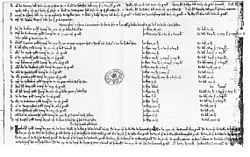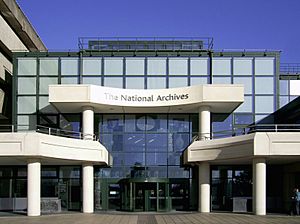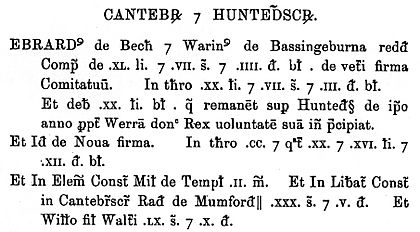Pipe rolls facts for kids
Quick facts for kids Pipe rolls |
|
|---|---|

A look at the Pipe roll from 1194
|
|
| Language | Medieval Latin, Middle English |
| Date | 1130–1833 |
| Provenance | English Exchequer |
| Series | Pipe rolls |
| Genre | Accounting documents |
| Subject | Records of the audits of the English Exchequer |
| Period covered | 1130–1833 |
The Pipe rolls, also known as the Great rolls, were important financial records kept by the English government's Treasury, called the Exchequer. These records started in the 12th century and continued almost without a break until 1833. They are the oldest continuous set of government records in England, covering about 700 years!
These rolls are super helpful for historians, especially the early ones from the Middle Ages. They give us a peek into how money was managed back then. A similar set of records was made for Normandy (a part of France ruled by English kings), but those haven't survived as well as the English ones.
The Pipe rolls were like yearly reports. They recorded the money that sheriffs and other royal officials paid to the Treasury. They also listed debts owed to the king and money spent by royal officials. They got their name because the sheets of parchment were rolled up tightly for storage, looking like a pipe. While they recorded a lot of royal income, they didn't include everything, so they weren't exactly a full budget. A group called the Pipe Roll Society, started in 1883, has published many of these old rolls.
Contents
What are Pipe Rolls?
The Pipe rolls got their name from their shape. They were made from long pieces of parchment (like thick paper) that were rolled up tightly, looking like a "pipe." Some people thought they were named because they "piped" money into the Treasury, but that's not true. They were sometimes called the "roll of the treasury" or the "great roll of accounts."
How the Records Were Made
These rolls were records of yearly checks (audits) of the accounts from sheriffs and other officials. These checks usually happened around Michaelmas (September 29th) at the Exchequer, which was the English treasury. Before King John of England's time, these rolls were the only continuous records kept by the English government.
The Pipe rolls didn't record all government money. They mainly focused on the accounts of sheriffs and a few other income sources. They also didn't list every payment made by the Exchequer. They weren't meant to be a budget, but rather a record of the money that was checked and approved.
Money and Debts in the Rolls
In their early days, the rolls listed all debts owed to the king, whether from feudal duties (money paid by nobles for land) or other reasons. If a debt wasn't paid in one year, the rest of it was carried over to the next year's roll. So, to see a full history of a debt, you might need to look at several rolls.
Besides sheriffs, other people who submitted accounts included town officials and those in charge of church or noble estates. The oldest Pipe roll we still have is from 1129–30. The continuous series of rolls starts in 1155–56 and lasted for almost 700 years!
England's Advanced System
Compared to other countries in Western Europe, England was ahead of its time in keeping financial records. For example, France didn't have a similar system until the 1190s. The way England kept these records in rolls, instead of books, was also unique.
The Dialogus de Scaccario (Dialogue concerning the Exchequer), written around 1178, explains how the Exchequer worked and how the Pipe rolls were created. This book was written by Richard FitzNeal, whose father was the Treasurer for two kings. The Dialogue says the Pipe rolls were kept in the treasury because they were needed every day.
What Kind of Money Was Recorded?
The main income recorded was the "county farm," which was money from lands owned by the king. Sometimes, money from empty bishoprics or abbeys was also recorded. Payments could be in coins or even in goods like spices or livestock.
The only surviving roll from King Henry I's time also shows payments of "geld," an old land tax. Later, fines from royal courts (called Assizes) and "scutage" payments (money paid by knights instead of military service) were also recorded.
However, not all royal income went through the Exchequer, so the Pipe rolls don't show every penny the king received. For example, some payments went straight to the king's household and weren't recorded.
What About Spending?
The Pipe rolls also documented how the king spent money. This included payments for carts, horses, wages for royal servants, improvements to royal homes, gifts, hunting costs, and even the cost of bags to carry silver coins.
Other Interesting Information
The rolls sometimes contain other cool facts, like where prisoners were moved, which helps historians figure out which medieval castles were used as prisons. They also show who was in charge of royal lands and castles. Sometimes, the clerks writing the rolls even used them to make fun of government officials!
Missing Information
Some areas, like Durham and Chester, didn't report their income to the Exchequer, so they usually don't appear in the Pipe rolls. The county of Cornwall also rarely appeared. Another challenge for historians is that the financial year didn't always start and end on the same dates in every roll.
History of the Pipe Rolls

The earliest Pipe roll we have is from 1130, during King Henry I's reign. It's clear that these rolls were already well-established by then, meaning they had been made for some time before 1130. Historians debate exactly when they first started. Some think it was during Henry I's reign, while others believe they might have begun even earlier, with King William I (William the Conqueror).
After the 1130 roll, no Pipe rolls survived from the rest of Henry I's reign or from King Stephen's reign (1135–1154). But by 1155, during King Henry II's time, they started appearing again, and most have survived continuously since then.
Changes Over Time
The Pipe rolls grew very large and difficult to use by the time of King John. So, around 1206, they started a new system. Detailed receipts were recorded in separate "receipt rolls," and only the totals were put into the Pipe rolls. Later, in 1236, debts were moved to separate "Estreat rolls."
In 1284, new rules called the "Statutes of Rhuddlan" were made. These rules further simplified the Pipe rolls by removing even more detail. Many old, uncollectible debts were also taken off the rolls. More changes happened in the 1300s to make the rolls clearer and remove extra details like customs receipts and military accounts.
The Pipe roll series finally ended in 1834 when the office in charge of creating them was closed down.
How Pipe Rolls Were Made
Pipe rolls were made by taking the financial accounts from each county or district. These accounts were written on two strips of parchment, usually about 14 inches (36 cm) wide. These two strips were then joined end-to-end to make one long sheet.
Next, all the long sheets from different counties were stacked together and fastened at the top. The whole stack was then rolled up tightly, looking like a pipe. They weren't one super-long continuous roll like some other government documents. Each county's sheet had its name written in Latin at the top.
The rolls were written in Latin until 1733, except for a short period around 1650. During Henry II's reign, a duplicate copy of the Pipe roll was made for the Chancellor. This copy was called the Chancellor's roll and was almost identical to the main Pipe roll.
Influence on Other Records
The royal Exchequer's record-keeping system inspired others to create similar documents. For example, the earliest surviving non-royal Pipe rolls are from the Bishop of Winchester, starting in 1208. These rolls, like the royal ones, recorded money coming in, expenses, and payments in detail. Most private rolls that looked like Pipe rolls came from monasteries.
Studied by Historians
Many historians have studied the Pipe rolls to learn about financial and government history, especially from the medieval period. They have used them to understand how much money English kings had and how the judicial system worked. The rolls also help identify royal officials and judges from those times.
The single surviving Pipe roll from Henry I's reign (1130) has been a popular topic for study. Historians like Judith Green and Stephanie Mooers Christelow have looked at it to understand Henry I's financial system, his judicial system, and how royal courts grew.
Pipe rolls from the 13th century onwards are less important for historical study because other financial records from that time have also survived. However, even later Pipe rolls can sometimes be the only source for interesting facts, like where William Shakespeare lived at certain times!
Publication of the Rolls
The earliest Pipe rolls were published in the 1800s. The Pipe Roll Society was founded in 1883 to systematically publish these important documents. They have published all the rolls from 1158 to 1224, and some others too. Early volumes were printed in a special "record type" that looked like the original handwriting, but later volumes used normal type.
The Pipe Roll Society has also published other related texts, including the Chancellor's Roll and Norman Pipe Rolls.


